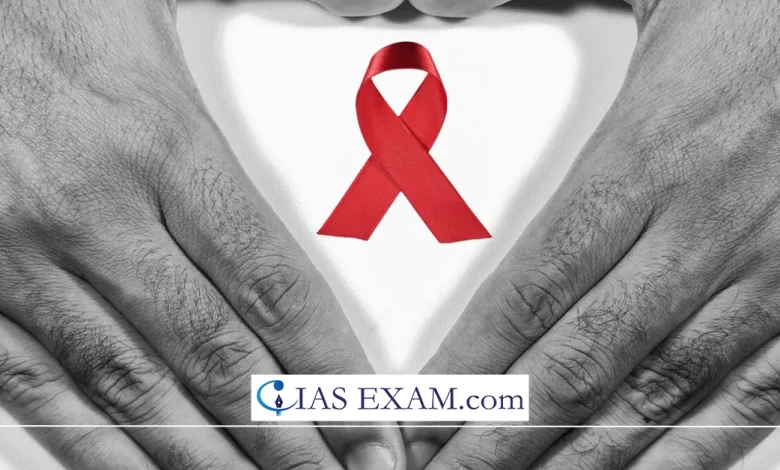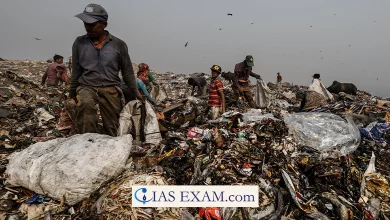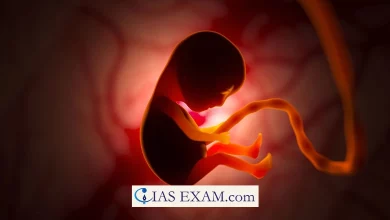Daily Current Affairs for UPSC
India’s response to the HIV/AIDS epidemic
Syllabus- Health [GS Paper-2]

Context
India’s response to the HIV/AIDS epidemic marked a significant milestone with the launch of Free Antiretroviral Therapy (ART) for Persons living with HIV (PLHIV).
Emergence of HIV/AIDS and Early Challenges
- The Beginning of a Global Health Crisis
-
-
- The emergence of HIV/AIDS in the early 1980s marked the start of a global health disaster that might have far-reaching outcomes for thousands and thousands of people worldwide.
- Initially identified amongst populations in the United States, the disease quickly spread across continents, which includes countries like India.
- This duration was characterised by uncertainty, fear, and a lack of knowledge about the new virus, which was to begin with referred to as GRID (Gay-Related Immune Deficiency) before being renamed HIV (Human Immunodeficiency Virus) and its associated disease AIDS (acquired immunodeficiency syndrome).
-
- A Death Sentence Due to Non-Availability of Treatment
-
-
- During the early years of the epidemic, HIV/AIDS was considered a dying sentence, broadly speaking due to the fact there had been no effective remedies available.
- The disease usually affected marginalized populations, including guys who have intercourse with men, intravenous drug users, and commercial intercourse people.
- However, as the epidemic progressed, it was evident that HIV/AIDS did not discriminate based on gender, sexual orientation, or socioeconomic fame, affecting people from all walks of life.
-
- A Social Stigma
-
-
- In addition to the devastating health outcomes, HIV/AIDS was accompanied by significant social stigma and discrimination.
- People residing with HIV/AIDS confronted ostracization, loss of employment, and rejection from their communities or even their families.
- This stigma similarly exacerbated the challenges of living with HIV/AIDS and hindered efforts to deal with the epidemic effectively.
-
- Limited Access to Treatment and High Cost of Available ART
-
- Despite the growing recognition of HIV/AIDS as a global health disaster, access to remedy remained restrained, mainly in low- and middle-income countries like India.
- The first antiretroviral drug, AZT (zidovudine), was permitted by the US Food and Drug Administration (US FDA) in March 1987.
- HAART represented a leap forward in coping with the disease with the aid of combining a couple of antiretroviral capsules to suppress viral replication and improve immune function.
- However, the prohibitively excessive value of HAART, that can amount to $10,000 a year consistent with patients, made it inaccessible to the majority of people living with HIV/AIDS, in particular the ones in resource-limited settings.
The Launch of Free ART in India
- Recognising the urgent need to deal with the challenges of constrained access to and affordability of HIV/AIDS treatment, the Indian authorities took a sizable step.
- On April 1, 2004, the government launched Free Antiretroviral Therapy (ART) for Persons residing with HIV (PLHIV).
- The release of Free ART aimed to break down boundaries to remedy and make life-saving medication on hand to all PLHIV, regardless of their capacity to pay.
- By offering ART free of cost, the government sought to make certain that nobody could be denied remedy because of financial constraints, hence addressing a vital hole in healthcare transport.
The Impact of Free ART and Its Role in Halting the Epidemic
- Better Access to Treatment
-
-
- Over the past two years, the program has increased substantially, with the wide variety of ART centres growing from less than 10 to around seven-hundred, serving about 1.8 million PLHIV.
- This enlargement has facilitated extra access to treatment for individuals living with HIV/AIDS throughout the country, such as in remote and underserved regions.
- One of the most effective outcomes of the Free ART initiative has been the dramatic improvement in health consequences for PLHIV.
-
- Reduced the Risk of Death Significantly and Transmission
-
-
- Access to timely and powerful treatment has transformed HIV/AIDS from a death sentence to an attainable persistent situation for many individuals.
- By suppressing viral load and boosting the immune system, ART has not only prolonged the lives of PLHIV but additionally advanced their best of life.
- Moreover, the Free ART initiative has played an important position in lowering HIV transmission values. By ensuring that PLHIV has access to remedy, the program allows to restrict the spread of the virus in communities.
- Studies have shown that effective ART can significantly reduce the chance of HIV transmission, contributing to the overall decline in HIV incidence.
-
- Broader Societal Impact
-
- Beyond its direct impact on individuals living with HIV/AIDS, the Free ART initiative has also had broader societal benefits.
- By lowering the burden of disease and preventing new infections, this system has helped to alleviate the social and economic impact of HIV/AIDS on families, communities, and the healthcare system.
Complementary Initiatives and Patient-Centric Approach
- The fulfillment of India’s ART application can not be attributed solely to free medication.
- Complementary initiatives, inclusive of free diagnostic facilities, prevention of parent-to-infant transmission services, and management of opportunistic infections, have played a crucial role in halting the HIV epidemic.
- Additionally, this system has followed a patient-centric approach, providing two to three months of medicines to stable PLHIV to minimize clinic visits and improve adherence to treatment.
Challenges and Future Directions
- Delayed Enrolment and Loss to Follow-Up
-
-
- A considerable proportion of sufferers of HIV disease, indicated by a low CD4 matter, which reduces the effectiveness of treatment.
- Additionally, loss to observe-up remains a subject, with some patients discontinuing treatment after they start to feel well, leading to treatment interruptions and the development of drug resistance.
-
- Supply Chain and Infrastructure Issues
-
-
- Remote and underserved areas, along with hilly and difficult terrain, face specific issues in getting access to critical drug treatments and healthcare services.
- Strengthening the supply chain and infrastructure for turning in ART medicine is crucial to ensure uninterrupted access to treatment for all PLHIV.
-
- Private Sector Engagement
-
-
- While the general public sector performs a crucial role in presenting HIV/AIDS remedy, there’s a need for more engagement with the private sector.
- Leveraging the resources and infrastructure of personal healthcare providers can help enlarge access to ART and reach underserved populations, such as the ones in urban areas.
-
- Integration with Other Health Programs
-
-
- Strengthening integration with different health applications, such as the ones addressing hepatitis, non-communicable diseasees, and mental health, is important.
- PLHIV regularly have co-morbidities that require complete and integrated healthcare services, necessitating collaboration among different sectors of the healthcare system.
-
- Achieving Ambitious Targets of NACP Phase five
-
- The ongoing fifth segment of the National AIDS Control Programme (NACP) aims to achieve ambitious objectives, along with lowering annual new HIV infections and AIDS-related mortalities by 80% by 2025.
- Attaining those objectives calls for concerted efforts to boom testing, enhance remedy insurance, and ensure viral suppression among PLHIV.
Conclusion
- India’s free ART initiative has been instrumental in bending the curve of the HIV/AIDS epidemic, demonstrating the transformative strength of reachable and less expensive healthcare.
- The success underscores the importance of political will, sustained investment, community engagement, and patient-concentrated care in preventing infectious diseases.
- As India keeps its fight towards HIV/AIDS and explores new frontiers in public health, the classes found out from the ART application will function as a guiding light for future initiatives aimed toward enhancing health results for all.
Source: The Hindu
UPSC Prelims Practice Question
Q.Which of the following diseases can be transmitted from one person to another through tattooing? (2013)
- Chikungunya
- Hepatitis B
- HIV-AIDS
Select the correct answer using the codes given below:
(a) 1 only (b) 2 and 3 only
(c) 1 and 3 only (d) 1, 2 and 3
Ans – “b”





.png)



